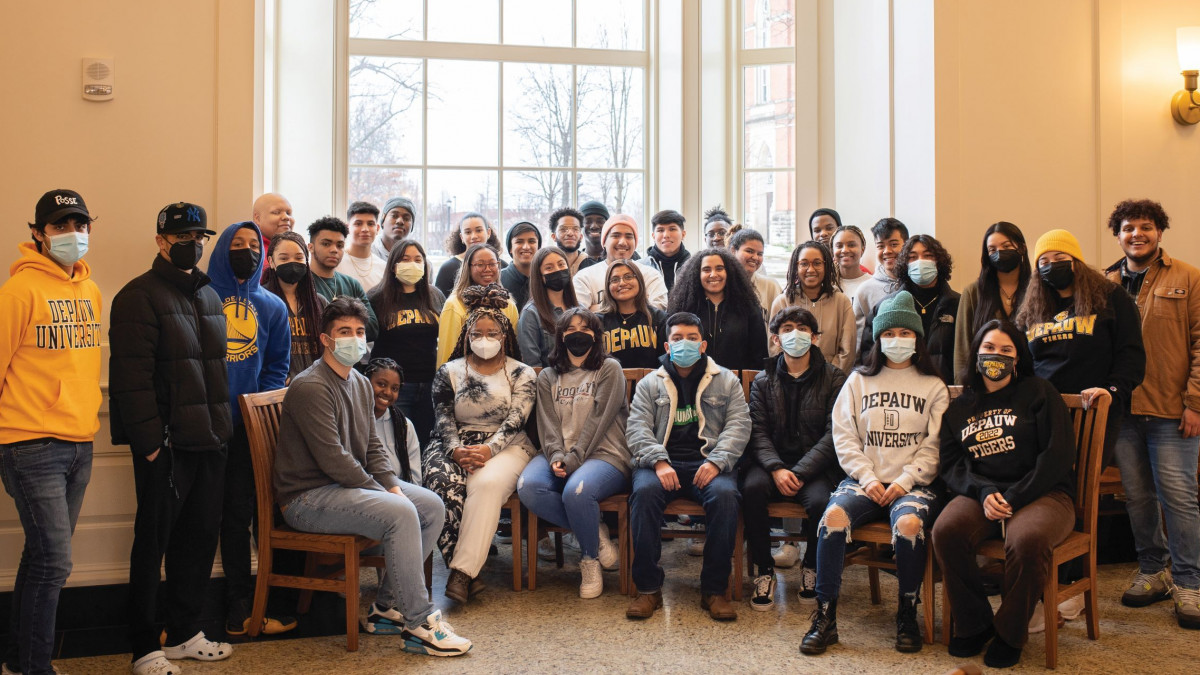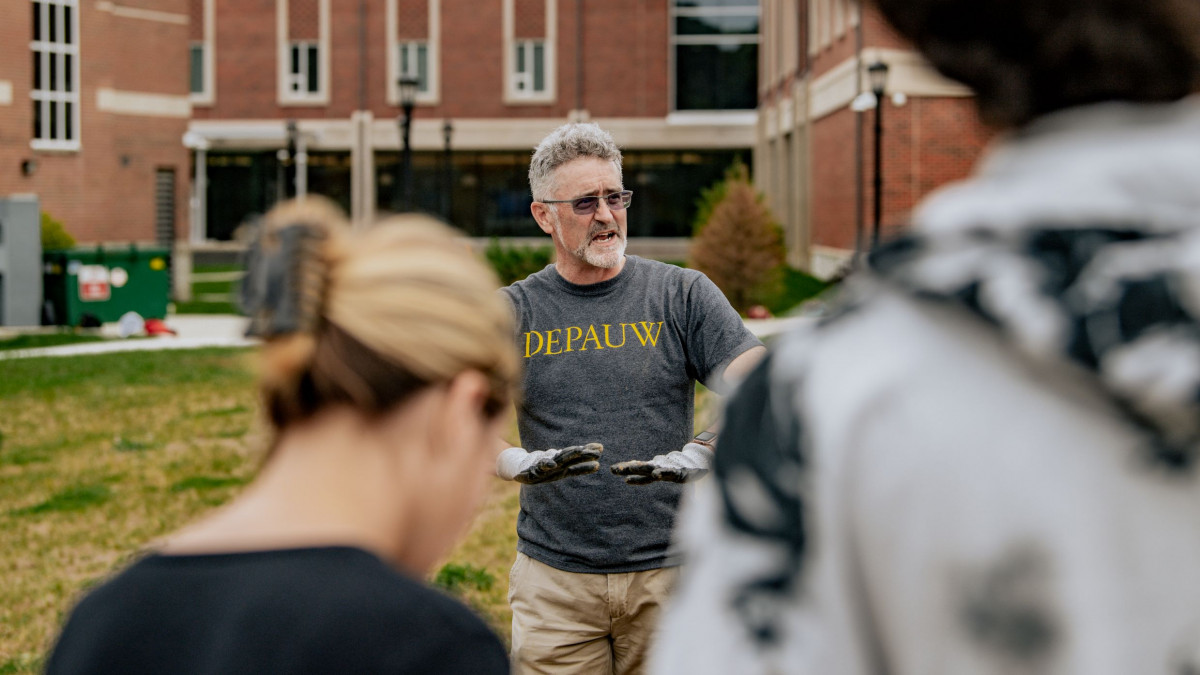The Bo(u)lder Question
is a regular feature of DePauw Magazine, which is published three times a year.
Archaeologists have dated the devastating eruption of Mount Vesuvius to AD 79, but opinions have differed on the exact date on which the people of Pompeii met their fate. That is, until Pedar Foss, classical studies professor and chair at DePauw, figured it out. We asked him:
When exactly did Mount Vesuvius erupt?
In AD 79, at the height of the Roman empire, Mount Vesuvius erupted, obliterating towns, farms and seaside villas in the Bay of Naples. Lost until the 18th century, the well-preserved ruins of Pompeii, Herculaneum and other sites have since captivated generations of archaeologists and visitors. The eruption is one of the few historical events that might be dated precisely, but literary and archaeological sources have seemed to provide divergent dates. Recently, the find of a charcoal inscription at Pompeii with “17 October” suggested an eruption of Oct. 24, challenging the traditional Aug. 24 date recorded in the oldest writings by Pliny the Younger, a Roman senator who witnessed the eruption when he was a boy of 17. Scholarly opinion over the last 20 years has split over which date is correct.
 Now, after a nine-year study of all the ancient, medieval and modern evidence, I have clarified what Pliny actually wrote. I had to gather all surviving manuscripts of Pliny’s “Letters.” Previous studies employed about 25, but I examined 79. I recorded all variants among the Latin texts and used both traditional methods of side-by-side comparison, called “collation,” and modern statistical analysis of some 170,000 data points of different readings, with the help of Bryan Hanson, emeritus professor of chemistry and biochemistry at DePauw. This led to a new “family tree” of manuscripts that mapped out how the errors were propagated over the nearly 1,400 years between Pliny’s original and the first printed editions.
Now, after a nine-year study of all the ancient, medieval and modern evidence, I have clarified what Pliny actually wrote. I had to gather all surviving manuscripts of Pliny’s “Letters.” Previous studies employed about 25, but I examined 79. I recorded all variants among the Latin texts and used both traditional methods of side-by-side comparison, called “collation,” and modern statistical analysis of some 170,000 data points of different readings, with the help of Bryan Hanson, emeritus professor of chemistry and biochemistry at DePauw. This led to a new “family tree” of manuscripts that mapped out how the errors were propagated over the nearly 1,400 years between Pliny’s original and the first printed editions.
A simple scribal mistake, made sometime in the 1420s, of switching a “u” for an “n” for the Roman date resulted in an incorrect date of “1 November.” This error grew in a key branch of texts that was used for the second print edition in 1474. Once that November date came into the novel and fast-growing circulation of printed books, it proliferated – and, like false claims on social media today – spawned further misreadings, misunderstandings and misuses. By the 20th century, seven different possibilities were in circulation (eight, if you count Mark Twain’s “9th of November”). Those many options gave the appearance of doubt concerning what Pliny actually wrote but, upon examination, I was able to explain away each of the mistaken alternatives.
Advances in scientific archaeology continue to offer new techniques for dating the past, but so far, studies of fish, pomegranates, grapes, figs, nuts, pinecones, pollen, clothes, coins and wind patterns have not proven sufficiently precise to confirm any particular date. I provide details of my investigation in my new book: “Pliny and the Eruption of Vesuvius,” which includes new translations and commentaries for Pliny’s letters about the disaster. The data I used are publicly available on the Routledge website, where readers may see the evidence for themselves. I took this step to demonstrate that, even in an age when every claim seems to be contested, careful research process and presentation can produce results with a high degree of certainty. Settling on a date of Aug. 24 should now make it possible to use the Vesuvian eruption as a reliable chronological measuring stick for future investigations of the past.
Photo: Foss teaches an archaeology class.
DePauw Magazine
Summer 2022
 Adventure! Searching for Shackleton
Adventure! Searching for Shackleton Alum dives into uncharted waters of Cuba for tourism business
Alum dives into uncharted waters of Cuba for tourism business Voyage to the center of Earth gives caver the thrill of discovery
Voyage to the center of Earth gives caver the thrill of discovery Fascination with exploration spurs alum to visit 7 continents
Fascination with exploration spurs alum to visit 7 continents Yo ho! Yo ho! A sailor’s life for Stotesbery
Yo ho! Yo ho! A sailor’s life for Stotesbery Zimbabwean student lives dream, heads to Greencastle
Zimbabwean student lives dream, heads to Greencastle ‘Accidental nomad’ responds to whisper and whim
‘Accidental nomad’ responds to whisper and whim Alum discovers adventure during Camino pilgrimages
Alum discovers adventure during Camino pilgrimages  Risk-taking entrepreneur seeks everyday adventure
Risk-taking entrepreneur seeks everyday adventure For 25 years, Posse program has produced leaders the world needs
For 25 years, Posse program has produced leaders the world needs Posse prepared alums to promote positive change
Posse prepared alums to promote positive change Posse leads to career excellence for these alums
Posse leads to career excellence for these alums Posse and DePauw partner to prepare promising professionals
Posse and DePauw partner to prepare promising professionals A message from the president
A message from the president The new VPs: Exploring new vistas at DePauw
The new VPs: Exploring new vistas at DePauw The Bo(u)lder Question by Pedar Foss
The Bo(u)lder Question by Pedar Foss First Person by Roland T. Rust ’74
First Person by Roland T. Rust ’74 DePauw Magazine: Adventure!
DePauw Magazine: Adventure!
DePauw Stories
A GATHERING PLACE FOR STORYTELLING ABOUT DEPAUW UNIVERSITY
Browse other stories
-
Athletics
-
Women's Lacrosse - Big Red Dominates in Second Quarter to Top the Tigers
-
Men's Tennis - Tigers Beat Wabash for Fourth Straight Win
-
Softball - DePauw Stays Unbeaten in NCAC with Sweep at Kenyon
More Athletics
-
-
News
-
Greencastle Celebrates National Main Street Day with Small Business Breakfast, New Program Launch, and Spring Pitch Competition
-
Hirotsugu "Chuck" Iikubo ’57 remembered as thoughtful leader, advocate for international goodwill
-
DePauw mourns Janet Prindle Seidler ’58, founder of The Prindle Institute for Ethics
More News
-
-
People & Profiles
-
11 alums make list of influential Hoosiers
-
DePauw welcomes Dr. Manal Shalaby as Fulbright Scholar-in-Residence
-
DePauw Names New Vice President for Communications and Strategy and Chief of Staff
More People & Profiles
-
-
Have a story idea?
Whether we are writing about the intellectual challenge of our classrooms, a campus life that builds leadership, incredible faculty achievements or the seemingly endless stories of alumni success, we think DePauw has some fun stories to tell.
-
Communications & Marketing
101 E. Seminary St.
Greencastle, IN, 46135-0037
communicate@depauw.eduNews and Media
-
News media: For help with a story, contact:
Bob Weaver, Senior Director of Communications.
bobweaver@depauw.edu.